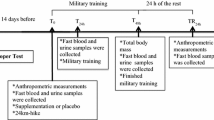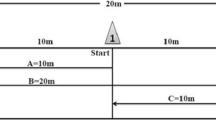Abstract
Purpose
Green tea extract (GTE) supplementation has been proposed to possess anti-inflammatory properties. This study assessed the effects of GTE on endurance training (ET) induced changes on irisin, pro-inflammatory cytokines, adiponectin and anthropometric indices in overweight middle-aged males.
Methods
Participants were randomly assigned to three groups (n = 15): endurance training + placebo (ET + P), endurance training + green tea extract supplementation (ET + GTE), and no endurance training + placebo (P). The ET intervention consisted of an 8-week training program that included circuit training, fast walking or jogging performed three times/week at a moderate intensity (40–59% of the heart rate reserve). Participants received 500 mg/day GTE using a green tea capsule. Serum concentrations of interleukin 6 (IL-6), tumor necrosis factor-alpha (TNF-α), irisin, adiponectin, and high-sensitivity C-reactive protein (hs-CRP) were measured prior to and after the 8-week training intervention.
Results
Both exercise interventions decreased IL-6 and hs-CRP (p < 0.05), and increased adiponectin (p < 0.01) levels; changes in these variables were greater in the ET + GTE group compared to the ET + P and P groups (p < 0.01). Irisin concentrations increased only in the ET + GTE group and were different from the ET + P and P groups (p < 0.01). There were no changes in TNF-α concentrations in any of the groups. Both exercise interventions (ET + GTE and ET + P) decreased bodyweight, body mass index (BMI), body fat percentage (BFP), and visceral fat area (VFA) (p < 0.05), with greater changes in these variables occurring in the ET + GTE group compared to ET + P and P groups (p < 0.01).
Conclusion
The combination of GTE supplementation and ET produces beneficial anti-inflammatory and metabolic effects, which were greater than those produced by ET alone.

Similar content being viewed by others
Abbreviations
- ET:
-
Endurance training
- GTE:
-
Green tea extract
- hs-CRP:
-
High-sensitivity C-reactive protein
- IL-6:
-
Interleukin 6
- TNF-α:
-
Tumor necrosis factor alpha
References
Alipour M, Malihi R, Hosseini SA, Abbasnezhad A, Ghavami A, Shahmohammadi HA, Ghanavati M (2018) The effects of catechins on related risk factors with Type 2 diabetes: a review. Progress Nutr 20:12–20
Amozadeh H, Shabani R, Nazari M (2018) The effect of aerobic training and green tea supplementation on cardio metabolic risk factors in overweight and obese females: a randomized trial. Int J Endocrinol Metab 16:4–11
Ashtary-Larky D et al (2018) Waist circumference to height ratio: better correlation with fat mass than other anthropometric indices during dietary weight loss in different rates. Int J Endocrinol Metab 16:5–10
Astrup A, Toubro S, Cannon S, Hein P, Breum L, Madsen J (1990) Caffeine: a double-blind, placebo-controlled study of its thermogenic, metabolic, and cardiovascular effects in healthy volunteers. Am J Clin Nutr 51:759–767
Auvichayapat P et al (2008) Effectiveness of green tea on weight reduction in obese Thais: a randomized, controlled trial. Physiol Behav 93:486–491
Bagheri R et al (2019a) Does green tea extract enhance the anti‐inflammatory effects of exercise on fat loss?. Br J Clin Pharmacol 2020:1–10
Bagheri R, Rashidlamir A, Motevalli MS, Elliott BT, Mehrabani J, Wong A (2019b) Effects of upper-body, lower-body, or combined resistance training on the ratio of follistatin and myostatin in middle-aged men. Eur J Appl Physiol 9:1921–1931
Baker RG, Hayden MS, Ghosh S (2011) NF-κB, inflammation, and metabolic disease. Cell Metab 13:11–22
Bogdanski P, Suliburska J, Szulinska M, Stepien M, Pupek-Musialik D, Jablecka A (2012) Green tea extract reduces blood pressure, inflammatory biomarkers, and oxidative stress and improves parameters associated with insulin resistance in obese, hypertensive patients. Nutr Res 32:421–427
Boström P et al (2012) A PGC1-α-dependent myokine that drives brown-fat-like development of white fat and thermogenesis. Nature 481:463
Bracco D, Ferrarra J-M, Arnaud MJ, Jequier E, Schutz Y (1995) Effects of caffeine on energy metabolism, heart rate, and methylxanthine metabolism in lean and obese women. Am J Physiol Endocrinol Metab 269:E671–E678
Butt MS, Ahmad RS, Sultan MT, Qayyum MMN, Naz A (2015) Green tea and anticancer perspectives: updates from last decade. Crit Rev Food Sci Nutr 55:792–805
Cabrera C, Artacho R, Giménez R (2006) Beneficial effects of green tea—a review. J Am Coll Nutr 25:79–99
Chen I-J, Liu C-Y, Chiu J-P, Hsu C-H (2016) Therapeutic effect of high-dose green tea extract on weight reduction: a randomized, double-blind, placebo-controlled clinical trial. Clin Nutr 35:592–599
Cunha CA et al (2013) Green tea extract supplementation induces the lipolytic pathway, attenuates obesity, and reduces low-grade inflammation in mice fed a high-fat diet. Mediator Inflam 2013:1–10
Dehghan M, Merchant AT (2008) Is bioelectrical impedance accurate for use in large epidemiological studies? Nutr J 7:26
Deurenberg P (1996) Limitations of the bioelectrical impedance method for the assessment of body fat in severe obesity. Am J Clin Nutr 64:449S–452S
Haghighatdoost F, Nobakht M, Gh BF, Hariri M (2017) Effect of green tea on plasma adiponectin levels: a systematic review and meta-analysis of randomized controlled clinical trials. J Am Coll Nutr 36:541–548
Hamer M (2007) The beneficial effects of tea on immune function and inflammation: a review of evidence from in vitro, animal, and human research. Nutr Res 27:373–379
Haramizu S, Ota N, Hase T, Murase T (2011) Catechins attenuate eccentric exercise-induced inflammation and loss of force production in muscle in senescence-accelerated mice. J Appl Physiol 111:1654–1663
Hecksteden A et al (2013) Irisin and exercise training in humans–results from a randomized controlled training trial. BMC Med 11:235
Hodgson AB, Randell RK, Boon N, Garczarek U, Mela DJ, Jeukendrup AE, Jacobs DM (2013) Metabolic response to green tea extract during rest and moderate-intensity exercise. J Nutr Biochem 24:325–334
Hsu C-H, Tsai T-H, Kao Y-H, Hwang K-C, Tseng T-Y, Chou P (2008) Effect of green tea extract on obese women: a randomized, double-blind, placebo-controlled clinical trial. Clin Nutr 27:363–370
Huh JY, Panagiotou G, Mougios V, Brinkoetter M, Vamvini MT, Schneider BE, Mantzoros CS (2012) FNDC5 and irisin in humans: I. Predictors of circulating concentrations in serum and plasma and II. mRNA expression and circulating concentrations in response to weight loss and exercise. Metabolism 61:1725–1738
Jo H-S, Baek Y-H (2006) Effects of combined exercise and green tea intake on body weight and adiponectin obese high school female. J Life Sci 16:972–977
Kelly DP (2012) Irisin, light my fire. Science 336:42–43
Kim H-S, Quon MJ, Kim J-A (2014) New insights into the mechanisms of polyphenols beyond antioxidant properties; lessons from the green tea polyphenol, epigallocatechin 3-gallate. Redox Biol 2:187–195
Korkmaz A et al (2019) Plasma irisin is increased following 12 weeks of Nordic walking and associates with glucose homoeostasis in overweight/obese men with impaired glucose regulation. Eur J Sport Sci 19:258–266
Liang R et al (2011) Green tea extract ameliorates reperfusion injury to rat livers after warm ischemia in a dose-dependent manner. Mol Nutr Food Res 55:855–863
Mazur-Biały A, Bilski J, Pocheć E, Brzozowski T (2017) New insight into the direct anti-inflammatory activity of a myokine irisin against proinflammatory activation of adipocytes: implication for exercise in obesity. J Physiol Pharmacol 68:2–10
McKay DL, Blumberg JB (2007) Roles for epigallocatechin gallate in cardiovascular disease and obesity: an introduction. J Am Coll Nutr 26:362S–365S
Mirzaei K, Hossein-Nezhad A, Karimi M, Hosseinzadeh-Attar M, Jafari N, Najmafshar A, Larijani B (2015) Effect of green tea extract on bone turnover markers in type 2 diabetic patients; a double-blind, placebo-controlled clinical trial study DARU. J Pharm Sci 1: 38–44
Murase T, Haramizu S, Shimotoyodome A, Tokimitsu I, Hase T (2006) Green tea extract improves running endurance in mice by stimulating lipid utilization during exercise. Am J Physiol Regul Integr Compar Physiol 290:R1550–R1556
Norheim F et al (2014) The effects of acute and chronic exercise on PGC-1α, irisin and browning of subcutaneous adipose tissue in humans. FEBS J 281:739–749
O’brien C, Young A, Sawka M (2002) Bioelectrical impedance to estimate changes in hydration status. Int J Sports Med 23:361–366
Pescatello LS, Riebe D, Thompson PD (2013) ACSM's guidelines for exercise testing and prescription. Lippincott Williams & Wilkins, Philadelphia
Phung OJ, Baker WL, Matthews LJ, Lanosa M, Thorne A, Coleman CI (2009) Effect of green tea catechins with or without caffeine on anthropometric measures: a systematic review and meta-analysis. Am J Clin Nutr 91:73–81
Racil G, Ounis OB, Hammouda O, Kallel A, Zouhal H, Chamari K, Amri M (2013) Effects of high vs. moderate exercise intensity during interval training on lipids and adiponectin levels in obese young females. Eur J Appl Physiol 113:2531–2540
Rains TM, Agarwal S, Maki KC (2011) Antiobesity effects of green tea catechins: a mechanistic review. J Nutr Biochem 22:1–7
Roberts JD, Roberts MG, Tarpey MD, Weekes JC, Thomas CH (2015) The effect of a decaffeinated green tea extract formula on fat oxidation, body composition and exercise performance. J Int Soc Sports Nutr 12:1
Rocha A, Bolin AP, Cardoso CAL, Otton R (2016) Green tea extract activates AMPK and ameliorates white adipose tissue metabolic dysfunction induced by obesity. Eur J Nutr 55:2231–2244
Rokling-Andersen MH et al (2007) Effects of long-term exercise and diet intervention on plasma adipokine concentrations. Am J Clin Nutr 86:1293–1301
Ryu O et al (2006) Effects of green tea consumption on inflammation, insulin resistance and pulse wave velocity in type 2 diabetes patients. Diabetes Res Clin Pract 71:356–358
Sang S, Lambert JD, Ho C-T, Yang CS (2011) The chemistry and biotransformation of tea constituents. Pharmacol Res 64:87–99
Shimada M, Mochizuki K, Sakurai N, Goda T (2007) Dietary supplementation with epigallocatechin gallate elevates levels of circulating adiponectin in non-obese type-2 diabetic Goto-Kakizaki rats. Biosci Biotechnol Biochem 71:2079–2082
Singh R, Akhtar N, Haqqi TM (2010) Green tea polyphenol epigallocatechi3-gallate: inflammation and arthritis. Life Sci 86:907–918
Surh Y-J, Chun K-S, Cha H-H, Han SS, Keum Y-S, Park K-K, Lee SS (2001) Molecular mechanisms underlying chemopreventive activities of anti-inflammatory phytochemicals: down-regulation of COX-2 and iNOS through suppression of NF-κB activation. Mut Res Fund Mol Mech Mutagen 480:243–268
Taghian F (2018) The impact of intensity interval training and supplementation of green tea on serum levels of irisin, insulin resistance in obese women with type 2 diabetes. Iran J Diabetes Metab 17:307–316
Thomas DT, Erdman KA, Burke LM (2016) Position of the academy of nutrition and dietetics, dietitians of Canada, and the American College of Sports Medicine: nutrition and athletic performance. J Acad Nutr Diet 116:501–528
Timmons JA, Baar K, Davidsen PK, Atherton PJ (2012) Is irisin a human exercise gene? Nature 488:E9
Wu CH, Lu FH, Chang CS, Chang TC, Wang RH, Chang CJ (2003) Relationship among habitual tea consumption, percent body fat, and body fat distribution. Obes Res 11:1088–1095
Yau SY et al (2014) Physical exercise-induced hippocampal neurogenesis and antidepressant effects are mediated by the adipocyte hormone adiponectin. Proc Natl Acad Sci 111:15810–15815
Acknowledgements
The authors wish to thank all the participants in this research project.
Author information
Authors and Affiliations
Contributions
RB, AR and HZ conceived and designed research. AR provided essential reagents. RB and DAL conducted experiments. AW contributed new reagents or analytical tools. AW and MSM analyzed data. RB and DAL wrote the manuscript. BG, JSB, IL and HZ revised the manuscript. AR and HZ had primary responsibility for final content. All authors read and approved the manuscript.
Corresponding authors
Ethics declarations
Conflict of interest
The authors declare no conflict of interest.
Additional information
Communicated by Philip D Chilibeck.
Publisher's Note
Springer Nature remains neutral with regard to jurisdictional claims in published maps and institutional affiliations.
Rights and permissions
About this article
Cite this article
Bagheri, R., Rashidlamir, A., Ashtary-Larky, D. et al. Effects of green tea extract supplementation and endurance training on irisin, pro-inflammatory cytokines, and adiponectin concentrations in overweight middle-aged men. Eur J Appl Physiol 120, 915–923 (2020). https://doi.org/10.1007/s00421-020-04332-6
Received:
Accepted:
Published:
Issue Date:
DOI: https://doi.org/10.1007/s00421-020-04332-6




